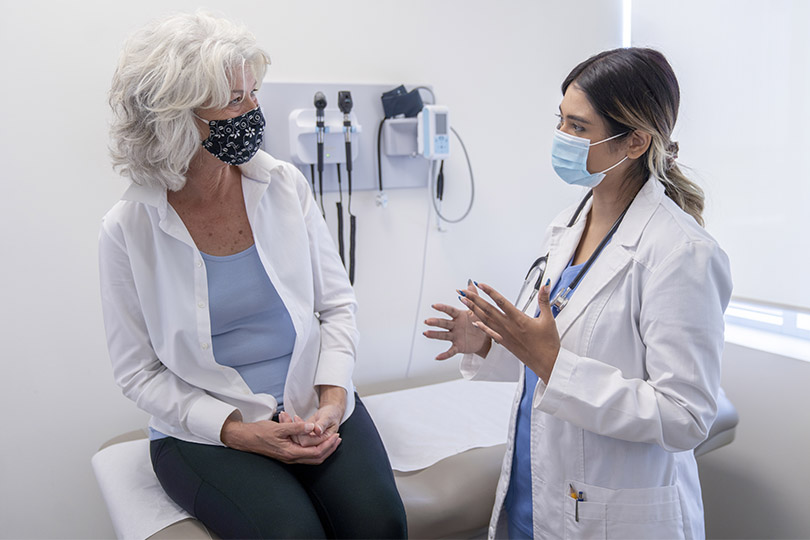Movement Disorders
Movement Disorder Treatment and Support
Movement disorders are very common, especially in the elderly population. They include a variety of neurological conditions that are generally caused by dysfunction in a region of the brain called the basal ganglia. The most widely known movement disorder is Parkinson’s disease, which affects between 1,000,000 and 1,500,000 individuals in the United States, with some 20,000 new cases diagnosed each year.
There are two basic categories of movement disorders:
- Hypokinetic – These movement disorders exhibit slow movement or a lack of movement. Parkinson’s disease is a prime example.
- Hyperkinetic – These movement disorders are characterized by excessive movement. This category includes conditions such as tremor, chorea (writhing movements), myoclonus and tics.
Movement Disorders Center at LHMC
The Lahey Hospital & Medical Center Movement Disorders Center provides diagnosis, treatment and support to patients with movement disorders. Our multidisciplinary team involves collaboration among specialists from Lahey’s Neurology, Neurosurgery, and Physical and Speech Therapy Departments. The staff can provide comprehensive care to patients with movement disorders and are trained and experienced in meeting their special needs. Treatment options include Botox injections, deep brain stimulation surgery, and other surgical interventions, when appropriate.
Our movement disorders specialist is Diana Apetauerova, MD. She evaluates and plans treatment for patients with movement disorders who need surgical therapy.
To make an appointment, please call 781-744-8631.
Movement Disorder Services Offered
Members of the Movement Disorders Center are experienced clinicians in the movement disorders field. The initial evaluation includes a thorough medical history and physical examination, as well as additional tests, if needed.
Upon diagnosis of Parkinson’s disease (PD), the patient is offered comprehensive assessment, which includes prescheduled, same-day neurological, physical and speech therapy/evaluation. Patients with all stages of PD (including patients who have had deep brain stimulation surgery) can be included in this evaluation. If needed, a social worker and occupation therapist may also participate.
The Day Program is a prolonged outpatient visit for Parkinson’s patients. It is a highly personalized program designed to allow closer physician and physician’s assistant assessment of the patient’s medication response and functional status. It allows for better adjustment of medications for complicated patients with motor fluctuations, dyskinesia, gait disorder and frequent freezing.
Presurgical evaluation includes detailed explanation about the surgical procedure, testing of the severity of PD by a special Parkinson’s disease rating scale, brain MRI or CT and, when indicated, detailed neuropsychological evaluation.
Lahey Hospital & Medical Center was first in the Boston area to perform the use of deep brain stimulation (DBS) in the subthalamic nucleus.
In the treatment of certain movement disorders, the ability to make small lesions deep in the brain has been available at a few centers for many years. However, only recently has the ability to provide DBS, accomplished by placing small electrodes in certain brain regions, been sufficiently refined to treat movement disorders. DBS can be very effective in treating both Parkinson’s disease and essential tremor (ET), as well as the movement disorders associated with multiple sclerosis and some types of dystonia.
Unlike older lesion techniques, in situations where the results are not optimal, the stimulators can be fine-tuned to achieve maximal results and turned off or removed, if necessary. In addition to deep brain stimulation, we still perform both pallidotomies and thalamotomies in select patients, when indicated. DBS is another example of how we continue to offer cutting-edge, state-of-the-art techniques to patients with movement disorders.
The Stimulator Clinic is designed for patients who have undergone DBS surgery for PD, essential tremor or dystonia. It includes short or prolonged stimulation sessions, depending upon the patient’s symptoms. The goal is to achieve the best control of the most bothersome symptoms (e.g., tremor, slowness, stiffness, dyskinesia, dystonia, gait).
A general Botox clinic meets once weekly, and a specialized Botox clinic meets on the fourth Friday of each month. The specialized Botox clinic features ENT specialists trained in alleviating spasmodic dysphonia, jaw dystonia, drooling and vocal tics related to Tourette syndrome.
This newly established support group meeting is designed for patients who have undergone deep brain stimulation surgery for Parkinson’s disease, essential tremor and/or dystonia, as well as their family members. The group is also open to patients who are interested in the surgery in the future. The meetings take place twice a year at Lahey Hospital & Medical Center.
This support group is designed for patients with Parkinson’s disease who are being treated at Lahey Hospital & Medical Center. It meets twice a year.
Types of Movement Disorders
- Ataxia
- Atypical parkinsonism (MSA, CBD and PSP)
- Dystonia
- Essential tremor
- Huntington’s disease
- Myoclonus
- Parkinson’s disease
- Restless legs syndrome
- Sydenham’s chorea
- Tarditive dyskinesia
- Tics/Tourette syndrome
- Wilson disease

